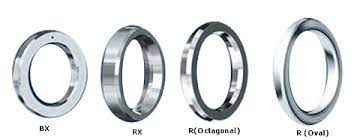Unraveling the Differences Between R, RX, and BX O-Ring Gaskets
In settings marked by intense pressure and elevated temperatures, where regular gaskets prove inadequate, O-ring gaskets emerge as resilient metallic solutions crafted for flawless sealing. Varied in types, sizes, and materials, the R, RX, and BX gaskets stand out, each meticulously designed to meet specific industrial requirements.

R Type Ring Joint Gasket: Unveiling Simplicity
The R Type Ring Joint Gasket emerges as the elemental choice for low-pressure applications. Characterized by its octagonal shape with flat sides and rounded edges, this gasket, crafted from soft iron, low carbon steel, or stainless steel, thrives in moderate pressure and temperature environments. Its high compressibility allows it to conform to uneven surfaces, ensuring a steadfast seal—a trait ideal for pipeline flanges.
RX Type Ring Joint Gasket: Elevating Sealing Prowess
Progressing in design, the RX Type Ring Joint Gasket caters to high-pressure scenarios. Still octagonal but with a modified twist—a narrow groove on the sealing face—RX Type Gaskets boast enhanced sealing capabilities, particularly excelling under elevated pressures. Primarily employed in the oil and gas industry, these gaskets hold their ground in environments that demand resilience against formidable pressures.
BX Type Ring Joint Gasket: Mastering Extremes
At the zenith of O-ring gasket sophistication lies the BX Type Ring Joint Gasket. Unveiling a trapezoidal cross-section with a flat bottom and angled sides, BX Type Gaskets are forged from robust materials like stainless steel or Inconel. Capable of withstanding pressures scaling up to 20,000 psi, these gaskets find their niche in the most severe high-pressure and high-temperature applications, notably in the oil and gas industry's wellheads and Christmas tree assemblies.
Deciphering Distinctions: R vs. RX vs. BX
O-ring gaskets are commonly used in various industries to create a seal between two mating surfaces, preventing the leakage of fluids or gases. The distinctions among R, RX, and BX O-ring gaskets refer to specific types of ring gaskets, each designed for different applications.
Making Informed Choices
In the high-pressure and high-temperature industrial landscapes, the selection of the right O-ring gasket becomes a strategic decision. By discerning the subtleties among R, RX, and BX Ring Joint Gaskets—evaluating shapes, sealing capacities, materials, and pressure-temperature ratings—users empower themselves to make judicious choices, ensuring optimal performance in their unique applications.

R Type Ring Joint Gasket: Unveiling Simplicity
The R Type Ring Joint Gasket emerges as the elemental choice for low-pressure applications. Characterized by its octagonal shape with flat sides and rounded edges, this gasket, crafted from soft iron, low carbon steel, or stainless steel, thrives in moderate pressure and temperature environments. Its high compressibility allows it to conform to uneven surfaces, ensuring a steadfast seal—a trait ideal for pipeline flanges.
RX Type Ring Joint Gasket: Elevating Sealing Prowess
Progressing in design, the RX Type Ring Joint Gasket caters to high-pressure scenarios. Still octagonal but with a modified twist—a narrow groove on the sealing face—RX Type Gaskets boast enhanced sealing capabilities, particularly excelling under elevated pressures. Primarily employed in the oil and gas industry, these gaskets hold their ground in environments that demand resilience against formidable pressures.
BX Type Ring Joint Gasket: Mastering Extremes
At the zenith of O-ring gasket sophistication lies the BX Type Ring Joint Gasket. Unveiling a trapezoidal cross-section with a flat bottom and angled sides, BX Type Gaskets are forged from robust materials like stainless steel or Inconel. Capable of withstanding pressures scaling up to 20,000 psi, these gaskets find their niche in the most severe high-pressure and high-temperature applications, notably in the oil and gas industry's wellheads and Christmas tree assemblies.
Deciphering Distinctions: R vs. RX vs. BX
O-ring gaskets are commonly used in various industries to create a seal between two mating surfaces, preventing the leakage of fluids or gases. The distinctions among R, RX, and BX O-ring gaskets refer to specific types of ring gaskets, each designed for different applications.
- Shape: R Type Gaskets flaunt an octagonal shape, RX Types maintain the octagonal theme with a tweaked design, while BX Types present a trapezoidal form.
- Sealing Capacity: The hierarchy of sealing capacities is clear, with BX Gaskets leading the pack, trailed by RX and R Types.
- Material Composition: R Types find companionship in soft iron, low carbon steel, or stainless steel; RX Types prefer the softer touch of low carbon steel, while BX Types are cast from the sturdier realms of stainless steel or Inconel.
- Pressure and Temperature Ratings: Tailored for specific environments, R Types suit low-pressure and moderate-temperature scenarios, RX Types navigate high-pressure with moderate temperatures, and BX Types conquer the extremes of high-pressure and high-temperature applications.
Making Informed Choices
In the high-pressure and high-temperature industrial landscapes, the selection of the right O-ring gasket becomes a strategic decision. By discerning the subtleties among R, RX, and BX Ring Joint Gaskets—evaluating shapes, sealing capacities, materials, and pressure-temperature ratings—users empower themselves to make judicious choices, ensuring optimal performance in their unique applications.

